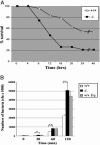Lipocalin 2-deficient mice exhibit increased sensitivity to Escherichia coli infection but not to ischemia-reperfusion injury
- PMID: 16446425
- PMCID: PMC1413671
- DOI: 10.1073/pnas.0510847103
Lipocalin 2-deficient mice exhibit increased sensitivity to Escherichia coli infection but not to ischemia-reperfusion injury
Abstract
Diverse functions have been reported for lipocalin 2. To investigate these functions in vivo, we generated gene-targeted lipocalin 2-deficient mice (Lcn2-/- mice). In vitro studies have suggested that lipocalin 2 is important for cellular apoptosis induced by IL-3 withdrawal, and for the induction of kidney differentiation during embryogenesis. Analysis of Lcn2-/- mice showed normal cell death upon IL-3 withdrawal and normal kidney development. However, we found that Lcn2-/- mice exhibited an increased susceptibility to bacterial infections, in keeping with the proposed function of lipocalin 2 in iron sequestration. Neutrophils isolated from Lcn2-/- mice showed significantly less bacteriostatic activity compared with WT controls. The bacteriostatic property of the WT neutrophils was abolished by the addition of exogenous iron, indicating that the main function of lipocalin 2 in the antibacterial innate immune response is to limit this essential element. Another important function ascribed to lipocalin 2 has been its protective role against kidney ischemia-reperfusion injury. We analyzed Lcn2-/- mice using a mouse model for severe renal failure and could not detect any significant differences compared with their WT littermates.
Conflict of interest statement
Conflict of interest statement: No conflicts declared.
Figures



References
-
- Flower D. R., North A. C., Sansom C. E. Biochim. Biophys. Acta. 2000;1482:9–24. - PubMed
-
- Akerstrom B., Flower D. R., Salier J. P. Biochim. Biophys. Acta. 2000;1482:1–8. - PubMed
-
- Logdberg L., Wester L. Biochim. Biophys. Acta. 2000;1482:284–297. - PubMed
-
- Akerstrom B., Logdberg L., Berggard T., Osmark P., Lindqvist A. Biochim. Biophys. Acta. 2000;1482:172–184. - PubMed
-
- Akerstrom B., Logdberg L. Trends Biochem. Sci. 1990;15:240–243. - PubMed
Publication types
MeSH terms
Substances
LinkOut - more resources
Full Text Sources
Other Literature Sources
Medical
Molecular Biology Databases
Miscellaneous

